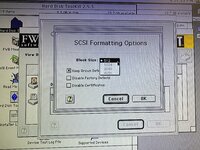Phipli
Well-known member
The thing I worry about is when they stop making writable CDs. I... get through a lot of blank CDs still and more and more am aware that I'm one of the last. I've noticed the quality of newly bought disks is going down hill too. I keep buying different brands and they write slowly and read badly, vs. my diminishing stockpile of 15+ year old disks that burn faster and read in anything :/I'm aware I'm the one who created the interest in optical and magneto optical technologies, talking about how the discs are the best possible archival technologies and the drives have proven themselves to be among the most reliable removable media technology formats for the '80s, '90s, and 2000s. I apologize for advocating for this in incomplete form.
I've since learned/remembered a few other things and whole MO is still the best available technology for the era, and the discs themselves will last forever, I think the drives may not:
The inevitability of time comes for all technologies. Did you ever have a playstation 2? I did and a couple years into having the thing, the laser for one of the disc types it supported suddenly went out, leaving us, if I remember correctly, able to play music and PS1 games but not PS2 games or watch DVDs with it.
As far as I know, the same is true of all optical technologies, even into the blu-ray era companies have been publishing press releases about working on the laser longevity problem. In minidiscs, you even see new-era machines from 2001-2005 that look absolutely pristine but have dead lasers, likely because despite their looks they have a lot of miles on 'em.
I don't know the underlying details of why, the best guess I have and that I've seen anyone else have is a combination of usage hours, age, and luck. Japanese minidisc machines will typically have been spinning and reading for hours a day for years on end whereas MO may have, ultimately, seen lighter duty since they can wait until it's time to do an actual r/w to light up the laser.
If SCSI DVD drives were hypothetically bootable on system 7 and/or system 7 had a UDF driver or we could make HFS/HFS+ formatted DVDs -- we'd still need to balance between DVD and MO in terms of what type of longevity we're looking for. The same is true of CD-ROMs and CD-ROMs have the advantage of that there are a lot more of 'em hanging around.
Once you author a DVD (or a CD) for a classic mac, you can back it up using dd or an ISO program on a modern computer and then re-burn it. Modern CD/DVD burners, parts, and discs are still being made.
Nobody is making maintenance parts for MO drives anymore. Ultimately -- as far as I know they're also not making maintenance parts for old SCSI DVD drives, so I don't know if that's actually a better solution.
So, changing course now may not be worthwhile since SCSI DVD drives will be nearly as uncommon as MO hardware and lots of the SCSI DVD equipment is out of stuff like mips/sparc/alpha/power workstations and servers
I suspect that we're not too far off from the most viable solution for bring-up on SCSI-era 68k/PPC Macs is to use modern SCSI replacer of some stripe. Several of them now do CDROM and hard disk emulation, so buying one to run externally as a bring-up tool in addition to internal ones is reasonable.
The nice thing there is with these SCSI replacers, can go right up to the maximum volume limits of these systems -- 4-gigs for '030s and 2TB for '040/PPCss running 7.6.1 or better. There's SCSI<>SATA Bridges for optical drives but I don't know if we've had a chance to try these with Macs. Maybe @Unknown_K has one of them?
In the mean-time, I think we should probably enjoy MO for what it is -- a fun aesthetic vintage technology with an unfortunate expiration date. (The discs themselves will almost certainly last until the HDOTU though.)
Secondarily: How much is there in terms of utilities and stuff anyway? Most of my OS 9 installs fit within ~4-5 gigs in terms of installed OS and all the software I use on 'em, let alone utilities and bring-up stuff.
Bring back the good Sony and TDK disks!

